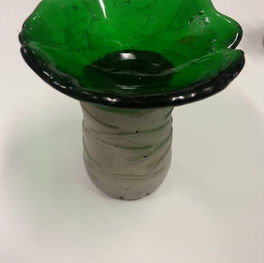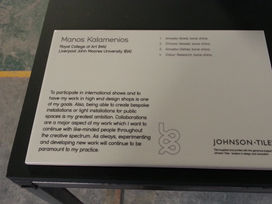top of page
Trio of Archetypes
This is the film I made as part of this project to display how the spoon I created works
1st Archetype - The Spoon

2nd Archetype - The Stool

3rd Archetype - The Bowl

These images are all from my first ever project I did whilst at the School of Art, and was based around the brief of three archetypes - The Spoons, The Stool and The Bowl.
British Ceramics Biennial 2017
~ Stoke-on-Trent ~
This was our very first project at the school of art and as we were starting our first round of inductions, we were tasked to use the skills that we were learning (at the time) as well as using our existing skill base, in order to help us carry out our brief. Our brief being that we had to create our own versions of three archetypes - the spoon, the stool and the bowl. Initially we were tasked with working in groups to gather ideas and initial research together about our first archetype - the spoon, as well as this we were asked to work in these groups to create different types of spoons from found and recycled materials in order to carry as many chocolates as possible from one end of the studio to the other - this task was meant for us not only to gather research on our first archetype but also to get us to get to know our fellow budding designers and to see how well we worked together in smaller groups. After this exercise we were then given a number of weeks to gather research into: the spoon, it uses / possible uses, contemporary spoon designers / makers and then from this test, design, test again and then finalise our spoon ideas. For this first part of the project I gathered initial research into the spoon, contextual research and created tester spoons using found objects and plastic waste. When making these testers I came up with and idea for a wearable spoon - the tester was made from a straw (as the handle), a plastic bottle (as the scoop section of the spoon) and a bent piece of wire (as the removable wrist strap). As a result of making this tester, I went on to researching not only other contemporary wearable spoon designs and the context for their different uses, but also researching different materials which could be used to make my wearable spoon. From this research I decided that I would use metal to make my spoon as it is the most widely used material to make spoons from, and as I was aiming to make a spoon which would be used for eating, I decided it was best to take inspiration from already existing cutlery serving sets - which are tried and tested. In order to take my earlier recycled tester and turn it into my finished metal spoon, I decided to try and use similar style materials and forms. To do this I decided I would use metal tubing in a similar width and length as the straw I used for handle and a circular metal scoop in a similar size to the one used in the tester. The reason I decided I wanted my finished spoon to be a metal replica of my tester, was because from this tester I found wearable spoon designs which were made for people with mobility issues so that they could eat without being fed by someone or without some form of assistance and therefore they had to be made of light-weight materials and as well if possible have more than one function - say if they were made for people with a degenerative condition such as Parkinson's or other similar conditions. As a result of this I decided to keep the same features but just change them into more user friendly versions - features such as the straw handle, changing it from an actual straw to a metal tube, this is because I thought that it would mean the spoon could be both used as a regular spoon and also as a drinking straw for soups, juices and other liquid foods. Plus by copying my tester idea it meant that my spoon would be more light-weight than other regular spoons, therefore it would also be easier for someone with a mobility issue to use. However, as by this time this section of the project was nearing it's end and I hadn't had any metal working inductions in the art school workshops (plus I only had very basic metal working skills at the time), I was unable to make the spoon myself and instead had to work with one of the metal working technicians in order to turn my wearable spoon design into a reality. Once I was helped to create my interpretation of the spoon archetype brief and this section of the overall project had come to an end, we were tasked with creating work for our next archetype - the stool. To start this second section of our project, I began by gathering contextual research, first looking at D.I.Y stool ideas (as I had never made a piece of furniture in my life) and then moved onto the works of contemporary furniture and stool designers. I then gathered my own first research into different stool forms, creating sketches of stools I saw around the different environments I visited; moving onto sketching different ones which I would possibly be able to create myself either with or without a technicians help - I also started to create little recycled models of the stools which could possibly be easier to create within the time frame we were given. However, as I previously mentioned I was not and am still not a furniture maker, I struggled to come up with any ideas or designs in which to make a stool from - but after having a helpful discussion with a member of the art school (who was working with us on this project), we came up with an idea together of how to get over my creative block. This idea was that I could change the idea of what a stool is and what the generic function of a stool is - for people to sit on. With this notion in mind, we decided together that my stool ideas could be scaled down and could be used for something besides sitting on - they could be used as plinths or 'stools' in which to display my bowls on once they were created. As I had discussed with her that I had considered making my stool from cast concrete/cement, she suggested that as I was scaling my idea down, that I could use plastic packaging: bottles, tubs etc. to cast into and create my stools from. Baring this idea in mind, I set to work collecting plastic bottles, tubs etc. which I could create design ideas from. Once these designs were done, I chose my favourite forms that I would use to inform which packaging I would use in order to cast my stools; from these designs I selected a range of different shapes and forms in which to test out. These selected vessels were then cleaned and taken with me to meet the art school technician who specialises in working with materials such as concrete and cement; with his help we mixed the concrete (which he had going spare in the outdoor workshop) which we then poured into the plastic vessels to cast them. When these had set and started to cure, they could be taken out of their moulds and be sanded down ready for the bowls to be placed on top and be used as bowl 'stools'. Finally, after creating these two sections of our archetype project (spoon, stool...), the bowl was last section to be completed. In order to start this new section of the project I once again collected research into the works of various designers who use a variety of materials to create their works. From this research I decided that the bowls which I preferred the most were the glass work ones, despite having finished our ceramics induction and the fact I also had previous knowledge and skills with this medium, I decided that I would make my bowls out of glass. Luckily as this project was in its final stages, we (me and a few other designers) were already well into our glass workshops by then, as a result of this I had already started to pick up some glass making techniques such as glass blowing, glass fusing and glass slumping - by the time this final stage of the project had started. So, because of this, I was able to use these basic skills of mine in order to make my glass bowls - as I wasn't such a fan of the hot glass work, I decided the I would create my bowls using cold glass or kiln-worked glass techniques such as fusing and slumping. As I had decided that I would pair my concrete 'stools' cast into recycle plastic vessels such as plastic bottles with the bowls I would create, I came up with the idea of using recycled glass from items such as bottles, in order to produce my bowls. To put this theory into motion, I started collecting glass from both the recycling at my accommodation and from the recycling boxes of local bars and pubs. In order to create a range of tests I not only selected different coloured glass bottles, but also recycled some glass from the waste bin in the in glass workshop. Once all this was cleaned and dried, I wrapped it in newspaper and broke it up into different sized pieces using a hammer, these pieces were then placed into tubs in colour coordination and set aside ready to be fused and then slumped. To ensure that my bowls would be somewhat concave (or bowl) shaped, I first drew different sized circles onto some thinfire paper (this stops the glass from fusing to the kiln shelf below), once drawn I then arranged my broken pieces of glass on the paper in different ways in order to create different effects - deciding to mix some the different types of glass together to see what result I would get. These were then locked in the kilns and the kilns were then set to the correct temperature in order for the glass to fuse together, when these had been fired and cooled, I observed my results and concluded that the smaller fused circles were the better of the samples because of their smaller scale they had fused together better than the larger ones which had a lot of weak links. The selected smaller fused circles were then placed onto shallow slumping moulds and then put back into the kilns, once fired and cooled again, they were ready to be sanded and polished. After sanding and polishing they were finally ready to be paired with their cast concrete 'stools', and then as result of these of bowls being made, the project was complete and our results were ready to be displayed and assessed. Looking back at this project now, I really did enjoy working with such different materials to create unique pieces of work - my favourite part I'd have say would be the glass and concrete work I made, as I love the fact I was able to pair them together to create a group of work that both contrasts with and compliments each other. Moreover, I also enjoyed working with waste and recycled materials in order to create something new with them; an ethos that I want to try and use with all of the projects I create, both professional and personal.
bottom of page



















































































